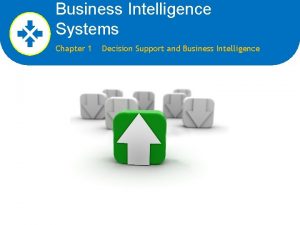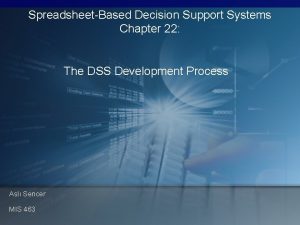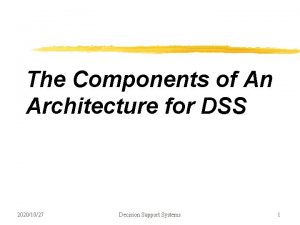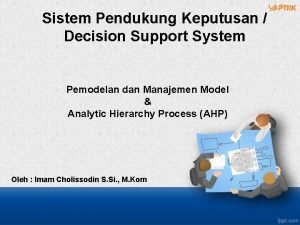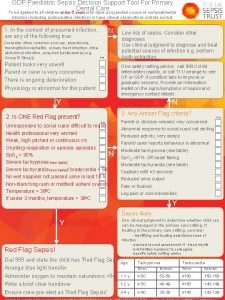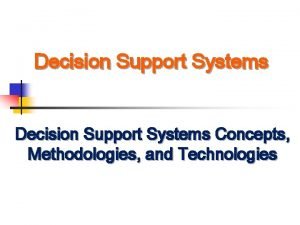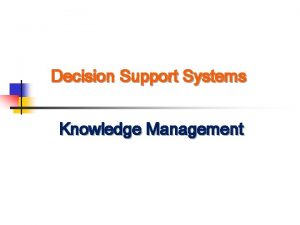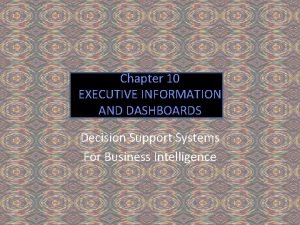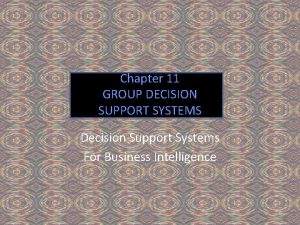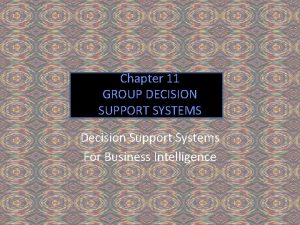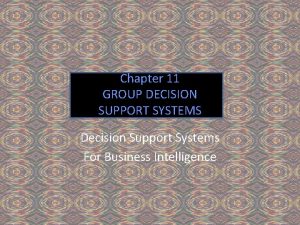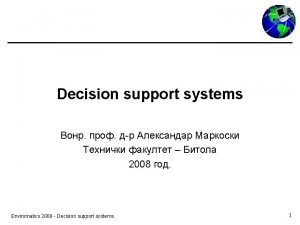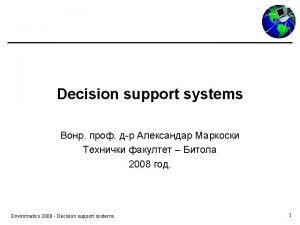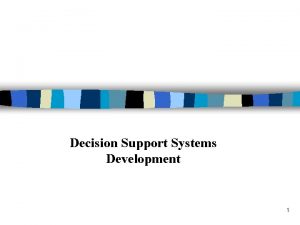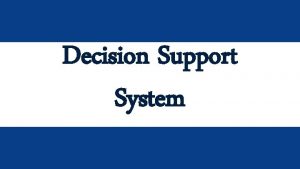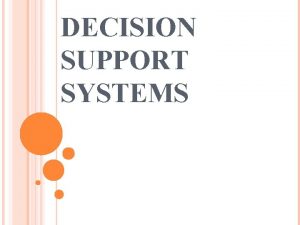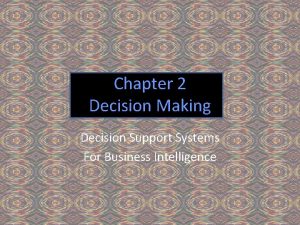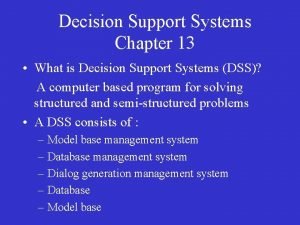Chapter 9 Decision Support Systems Mc GrawHillIrwin Copyright



























- Slides: 27

Chapter 9 Decision Support Systems Mc. Graw-Hill/Irwin Copyright © 2010 by the Mc. Graw-Hill Companies, Inc. All rights reserved.

Decision Support in Business Companies invest in data-driven decision support application frameworks to help them respond to Changing marketing conditions Customer needs Management information Accomplished by several types of Decision support Other information systems 2 - 27

Levels of Managerial Decision Making 3 - 27

Information Quality Information products are made more valuable by their attributes, characteristics, or qualities Outdated, inaccurate, or hard to understand information has much less value Information has three dimensions Time Content Form 4 - 27

Attributes of Information Quality 5 - 27

Decision Structured (operational) The procedures to follow when a decision is needed can be specified in advance Unstructured (strategic) It is not possible to specify in advance most of the decision procedures to follow Semi-structured (tactical) Decision procedures can be pre-specified, but not enough to lead to the correct decision 6 - 27

Decision Support Systems Management Information Systems Decision Support Systems Provide information about the performance of the organization Provide information and techniques to analyze specific problems Information form and frequency Periodic, exception, demand, and push reports and responses Interactive inquiries and responses Information format Pre-specified, fixed format Ad hoc, flexible, and adaptable format Information produced by extraction and manipulation of business data Information produced by analytical modeling of business data Decision support provided Information processing methodology 7 - 27

Business Intelligence Applications 8 - 27

Decision Support Systems l To support the making of semi-structured business decisions, DSS uses – Analytical models – Specialized databases – Decision-maker’s own insights and judgments – Interactive, computer-based modeling process l DS systems – Ad hoc, quick-response systems – Initiated and controlled by decision makers 9 - 27

DSS Components 10 - 27

DSS Model Base l Model Base – A software component – Consists of models used in computational and analytical routines – Mathematically expresses relationships among variables l Spreadsheet Examples – Linear programming – Multiple regression forecasting – Capital budgeting present value 11 - 27

Applications of Statistics and Modeling Supply Chain Simulate & optimize supply chain flows, reduce inventory & stock-outs Pricing Identify the price that maximizes yield or profit Product & Service Quality Detect quality problems early in order to minimize them Research & Development Improve quality, efficacy, and safety of products and services 12 - 27

Management Information Systems The original type of information system that supported managerial decision making Produces information products that support many day-to-day decision-making needs Produces reports, displays, and responses Satisfies needs of operational and tactical decision makers who face structured decisions 13 - 27

Management Reporting Alternatives Periodic Scheduled Reports Pre-specified format, issued on a regular basis Exception Reports about exceptional conditions, scheduled or on event Demand Reports & Responses Information is available on demand Push Reporting Information is pushed to a networked computer 14 - 27

Online Analytical Processing l OLAP – Enables managers and analysts to examine and manipulate large amounts of detailed and consolidated data from many perspectives – Done interactively, in real time, with rapid response to queries 15 - 27

Online Analytical Operations Consolidation Aggregation of data Ex: sales office data, rolled up to the district level Drill-Down Display underlying detail data Ex: sales figures by individual product Slicing and Dicing Viewing database from different viewpoints Often performed along a time axis 16 - 27

Geographic Information Systems (GIS) DSS uses geographic databases to construct and display maps and other graphic displays Supports decisions affecting the geographic distribution of people and other resources Often used with Global Positioning System (GPS) devices 17 - 27

Data Visualization Systems (DVS) Represents complex data using interactive, threedimensional graphical forms (charts, graphs, maps) Helps users interactively sort, subdivide, combine, and organize data while it is in its graphical form 18 - 27

Using Decision Support Systems l Using a decision support system involves an interactive analytical modeling process – Decision makers are not demanding pre-specified information – They are exploring possible alternatives 19 - 27

Using Decision Support Systems What-If Analysis Sensitivity Analysis Basic analytical modeling activities Goal-seeking Analysis Optimization Analysis 20 - 27

Data Mining l Decision support through knowledge discovery – Analyzes vast stores of historical business data – Looks for patterns, trends, and correlations – Goal is to improve business performance l Types of analysis – – – Regression Decision tree Neural network Cluster detection Market basket analysis 21 - 27

Market Basket Analysis l One of the most common uses for data mining – Determines what products customers purchase together with other products l Typical applications of MBA – Cross-selling – Product placement – Affinity promotion – Survey analysis – Fraud detection – Customer behavior identification 22 - 27

Executive Information Systems (EIS) Combines many features of MIS and DSS Provides top executives with immediate, easy access to information Identifies factors critical to accomplishing strategic objectives So popular it was expanded to managers, analysis, and other knowledge workers 23 - 27

Features of an EIS l Information presented in forms tailored to the preferences of the executives using the system – Customizable graphical user interfaces – Exception reports – Trend analysis – Drill down capability 24 - 27

Enterprise Information Portals l A Web-based interface and integration of MIS, DSS, EIS, and other technologies – Available to all intranet users and select extranet users – Provides access to a variety of internal and external business applications and services – Typically tailored or personalized to the user or groups of users – Often has a digital dashboard – Also called enterprise knowledge portals 25 - 27

Enterprise Information Portal Components 26 - 27

Enterprise Knowledge Portal 27 - 27
 Decision support systems and intelligent systems
Decision support systems and intelligent systems Objectives of decision making
Objectives of decision making Investment decision financing decision dividend decision
Investment decision financing decision dividend decision Decision support and business intelligence systems
Decision support and business intelligence systems Developing spreadsheet-based decision support systems
Developing spreadsheet-based decision support systems Decision support system in business intelligence
Decision support system in business intelligence Expert system in dss
Expert system in dss Chapter 2 economic systems and decision making answer key
Chapter 2 economic systems and decision making answer key Chapter 2 economic systems and decision making
Chapter 2 economic systems and decision making Chapter 2 economic systems and decision making
Chapter 2 economic systems and decision making Decision table and decision tree examples
Decision table and decision tree examples What are the types of information system
What are the types of information system Components of decision support system
Components of decision support system Contoh decision support system adalah
Contoh decision support system adalah Navify decision support
Navify decision support Gdp sepsis decision support tool
Gdp sepsis decision support tool Components of decision support system
Components of decision support system Gdss
Gdss Group decision support and groupware technologies
Group decision support and groupware technologies Bi vs dss
Bi vs dss Components of decision support system
Components of decision support system Types of decision support system
Types of decision support system Model driven decision support system
Model driven decision support system Decision support system in knowledge management
Decision support system in knowledge management Iliad clinical decision support system
Iliad clinical decision support system Excutive support system
Excutive support system Objectives of decision support system
Objectives of decision support system Chapter 10
Chapter 10



